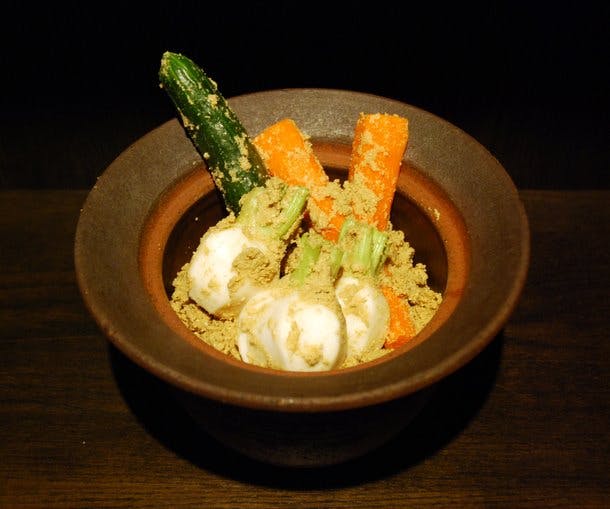
morning pickles
Discover the art of Japanese pickle-making at En Japanese Brasserie in New York. From nuka zuke rice bran pickles to asa zuke morning pickles, learn about the traditional techniques and ingredients used to create these flavorful and popular Japanese delicacies.
After my recent pickle-making experiment (see earlier below) I visited my friend Reika at En Japanese Brasserie, one of my favorite Japanese restaurants in New York. We ordered their oshinko -- pickles, a.k.a. cured vegetables -- and gave me a try. They tasted fantastic -- Chinese cabbage, cucumbers, carrots and turnips lightly cured to enhance the natural flavors. Mine, well, paled by comparison. How did the chef make them, I wondered? "Not the chef," Reika answered, but Miki, one of the servers who doubles as En's official pickle maker. Naturally, I had to have a chat with her.
I found Miki a couple of days later in the back of the kitchen, her arms elbow deep in a bucket of what looked like wet sawdust. "Nuka zuke," she explained -- rice bran pickles. The bucket held nuka doco, as the mix of rice bran, salt, water, red chilies and beer ("my secret ingredient") is called. It smelled like yeasty dough. Inside the brownish goop were whole carrots, cucumbers, turnips and Chinese cabbage. Miki fished out the vegetables as she mixed the nuka doco, which she has to take care of daily, the pickle version of a Chia Pet.
This all seemed too complicated for me to try at home. "I have something else," Miki said as she fetched a gallon-sized metal container from the walk-in fridge. The label on the side read asa zuke -- "morning pickles" -- a commonplace staple in Japanese households. She cures them overnight to serve next day -- hence the name "morning." Miki walked me through her pickle making process:
Miki starts by thinly slicing cucumbers, carrots and cabbage paper thin and soaking them in salt water for 30 minutes ("make sure the water tastes as salty as the ocean," she said by way of instruction). While the vegetables soak, she prepares a dashi (traditional bonito and konbu stock) and lets it cool. After a half an hour she squeezes excess salt water from the vegetables and dunks them in the dashi. She tops the mixture with a big sheet of konbu (hers was a foot and a half long), covers with plastic wrap and sticks in the walk-in. That's it. No sweat to make these at home. (Miki is going to email me the exact proportions for her recipe, which I'll post as soon as I receive it.)
